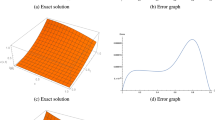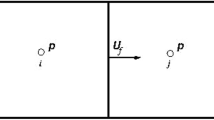Abstract
This paper presents a new parameter-free stability term via Galerkin mesh-free scheme to solve the multiscale behavior of steady-state advection-dominated advection–diffusion problems where the classical Galerkin method is shown to be unstable. A variational multiscale element-free Galerkin method (VMEFG) is proposed based on first-order local maximum entropy (LME) basis functions, which are owning weak Kronecker delta property that enables the imposition of essential boundary conditions with ease. In the present work, the finite space of the problem is enlarged by the infinite bubble space in the background integration cell. These bubbles constitute the fine scale solve locally (captures) the thin layers associated with the flow. Then, this bubble space solution is substituted into the coarse scales to recover the VMEFG method globally, which determines the parameter-free stability term naturally. The developed LME-based VMEFG is studied against three standard benchmark problems exhibiting boundary/internal layers and observed to be stable and robust in resolving all the layers. The effect of various values of locality parameter in defining the LME approximants is carried out between the values 1.2 and 2. It is found that the suboptimal solution is arrived at the locality parameter value, 1.5 and above 1.8, is not recommended. Convergence test is also carried out with two different mass functions and validated with the analytical solution and found that the computational efficiency of the present method is in good agreement with analytical solution.











Similar content being viewed by others
Abbreviations
- a:
-
Unknown constants in the approximation
- b :
-
Constant convective velocity
- G :
-
Hessian matrix
- h :
-
Characteristic nodal spacing
- H :
-
Shannon’s entropy
- \(k\) :
-
Diffusivity (m2 s−1)
- K1, K2, K3 :
-
Sub-cells of Delaunay triangular cell
- L 2 :
-
Error measure norm
- n :
-
Outward unit normal
- N :
-
Number of nodes
- N c :
-
Number of Delaunay triangular cells
- Pe:
-
Peclet number
- \(q_{{\text{N}}}\) :
-
Neumann boundary heat flux (W m−2)
- r i :
-
Radius of the support for each node
- s :
-
Prescribed source
- T :
-
Unknown scalar in the problem
- T h :
-
Approximation of the trail solution
- \(\bar{T}\) :
-
Coarse scale of the trail solution
- \(T^{\prime}\) :
-
Fine scale of the trail solution
- T D :
-
Scalar value on Dirichlet boundary
- w :
-
Prior mass function
- \(\bar{w}\) :
-
Coarse scale of the mass function
- \(w'\) :
-
Fine scale of the mass function
- x :
-
Coordinates of the nodes
- x i :
-
Scattered node set
- \(\tilde{{x}}_{{\text{i}}}\) :
-
Shifted coordinates
- \(H_{0}^{1}\) :
-
Hilbert space
- L 2 :
-
Lebesgue space
- V :
-
Subspace of Hilbert space
- V h :
-
Subspace of V
- \(\varOmega\) :
-
Domain of the problem
- \({{\text{d}}\varOmega }\), \(\varGamma\) :
-
Boundary of the domain
- \({\varGamma}_{{\text{N}}}\) :
-
Neumann boundary conditions imposed boundary
- \(\xi\) :
-
Bubble function
- \(\beta\) :
-
Pareto optimal parameter
- \(\gamma\) :
-
Locality parameter
- λ :
-
Lagrange Multiplier vector
- \(\emptyset_{{\text{i}}}\) :
-
Basis functions
- \(\tau\) :
-
Stabilization parameter
- a:
-
Local Point of interest within the Delaunay triangular cell
- cell:
-
Delaunay triangular cell of interest
- i:
-
Node of interest
- j:
-
Neighbor Node
- d:
-
Spatial dimension
- num:
-
Numerical solution
- exact:
-
Exact solution
References
Masud A, Khurram RA. A multiscale/stabilized finite element method for the advection–diffusion equation. Comput Methods Appl Mech Eng. 2004;193:1997–2018.
Brezzi F, Franca LP, Hughes TJR. Russo A. b = ∝ g. Comput Methods Appl Mech Eng. 1997;145:329–39.
Brooks AN, Hughes TJR. Streamline upwind/Petrov-Galerkin formulations for convection dominated flows with particular emphasis on the incompressible Navier-Stokes equations. Comput Methods Appl Mech Eng. 1982;32:199–200.
Franca LP, Frey SL, Hughes TJR. Stabilized finite element methods: I. Application to the advective-diffusive model. Comput Methods Appl Mech Eng. 1992;95:253–76.
Hughes TJR, Mallet M, Akira M. A new finite element formulation for computational fluid dynamics: II Beyond SUPG. Comput Methods Appl Mech Eng. 1986;54:341–55.
Shishkin GI, Roos H-G, Stynes M, Tobiska L. Numerical methods for singularly perturbed differential equations. Convection-diffusion and flow problems. J Appl Math. 1996;77:403.
Hughes TJR, Franca LP, Balestra M. A new finite element formulation for computational fluid dynamics: V. Circumventing the babuška-brezzi condition: a stable Petrov-Galerkin formulation of the stokes problem accommodating equal-order interpolations. Comput Methods Appl Mech Eng. 1986;59:85–99.
Hughes TJR, Franca LP, Hulbert GM. A new finite element formulation for computational fluid dynamics: VIII. The galerkin/least-squares method for advective-diffusive equations. Comput Methods Appl Mech Eng. 1989;73:173–89.
Franca LP, Farhat C. Bubble functions prompt unusual stabilized finite element methods. Comput Methods Appl Mech Eng. 1995;123:299–308.
Franca PL, Farhat C, Lesoinne M, Russo A. Unusual stabilized finite element methods and residual free bubbles. Int J Numer Methods Fluids. 1998;27:159–68.
Brezzi F, Bristeau M-O, Franca LP, Mallet M, Rogé G. A relationship between stabilized finite element methods and the Galerkin method with bubble functions. Comput Methods Appl Mech Eng. 1992;96:117–29.
Brezzi F, Franca LP, Russo A. Further considerations on residual-free bubbles for advective-diffusive equations. Comput Methods Appl Mech Eng. 1998;166:25–33.
Brezzi F, Houston P, Marini D, Süli E. Modeling subgrid viscosity for advection–diffusion problems. Comput Methods Appl Mech Eng. 2000;190:1601–10.
Brezzi F, Marini D, Russo A. Applications of the pseudo residual-free bubbles to the stabilization of convection-diffusion problems. Comput Methods Appl Mech Eng. 1998;166:51–63.
Brezzi F, Marini LD, Russo A. On the choice of a stabilizing subgrid for convection–diffusion problems. Comput Methods Appl Mech Eng. 2005;194:127–48.
Nesliturk AI. On the choice of stabilizing sub-grid for convection–diffusion problem on rectangular grids. Comput Math with Appl. 2010;59:3687–99.
Sendur A. A stabilizing augmented grid for rectangular discretizations of the convection–diffusion–reaction problems. Calcolo. 2018;55:986.
Sendur A, Nesliturk A, Kaya A. Applications of the pseudo residual-free bubbles to the stabilization of the convection–diffusion–reaction problems in 2D. Comput Methods Appl Mech Eng. 2014;277:154–79.
Franca LP, Nesliturk A, Stynes M. On the stability of residual-free bubbles for convection-diffusion problems and their approximation by a two-level finite element method. Comput Methods Appl Mech Eng. 1998;166:35–49.
Franca LP, Hwang F-N. Refining the submesh strategy in the two-level finite element method: application to the advection–diffusion equation. Int J Numer Methods Fluids. 2002;39:161–87.
Hughes TJR. Multiscale phenomena: Green’s functions, the Dirichlet-to-Neumann formulation, subgrid scale models, bubbles and the origins of stabilized methods. Comput Methods Appl Mech Eng. 1995;127:387–401.
Hughes TJR, Feijóo GR, Mazzei L, Quincy J-B. The variational multiscale method—a paradigm for computational mechanics. Comput Methods Appl Mech Eng. 1998;166:3–24.
Masud A, Khurram RA. A multiscale finite element method for the incompressible Navier-Stokes equations. Comput Methods Appl Mech Eng. 2006;195:1750–77.
Ayub M, Masud A. A new stabilized formulation for convective-diffusive heat transfer. Numer Heat Transf Part B Fundam. 2003;44:1–23.
Masud AA, Bergman L. Application of multi-scale finite element methods to the solution of the Fokker-Planck equation. Comput Methods Appl Mech Eng. 2005;194:1513–26.
Masud A, Hughes TJR. A stabilized mixed finite element method for Darcy flow. Comput Methods Appl Mech Eng. 2002;191:4341–70.
Coutinho ALGA, Franca LP, Valentin F. Numerical multiscale methods. Int J Numer Methods Fluids. 2012;70:403–19.
Hong K, Wang C, Xu F. Finite-element thermal analysis of flows on moving domains with application to modeling of a hydraulic arresting gear. J Therm Anal Calorim. 2020;56:88.
Mashayekhi R, Khodabandeh E, Akbari OA, Toghraie D, Bahiraei M, Gholami M. CFD analysis of thermal and hydrodynamic characteristics of hybrid nanofluid in a new designed sinusoidal double-layered microchannel heat sink. J Therm Anal Calorim. 2018;134:2305–15.
Dogonchi AS, Tayebi T, Chamkha AJ, Ganji DD. Natural convection analysis in a square enclosure with a wavy circular heater under magnetic field and nanoparticles. J Therm Anal Calorim. 2020;139:661–71.
Jain A, Sharma M, Kumar A, Sharma A, Palamanit A. Computational fluid dynamics simulation and energy analysis of domestic direct-type multi-shelf solar dryer. J Therm Anal Calorim. 2019;136:173–84.
Fries T-P, Matthies HG. Classification and Overview of Meshfree Methods. Inform der Tech Univ Braunschweig. Revised 20. Braunschweig: Institut f{ü}r Wissenschaftliches Rechnen; 2004;2003–03.
Wu CT, Young DL, Hong HK. Adaptive meshless local maximum-entropy finite element method for convection—diffusion problems. Comput Mech. 2014;76:189–200.
Cyron CJ, Nissen K, Gravemeier V, Wall WA. Information flux maximum-entropy approximation schemes for convection–diffusion problems. Int J Numer Methods Fluids. 2010;64:1180–200.
Nissen K, Wall WA. Pressure-stabilized maximum-entropy methods for incompressible Stokes. Int J Numer Methods Fluids. 2016;82:35–56.
Nissen K, Cyron C, Gravemeier V, Wall W. Information-flux method: a meshfree maximum-entropy Petrov-Galerkin method including stabilised finite element methods. Comput Methods Appl Mech Eng. 2012;241:225–37.
Nasiri H, Abdollahzadeh Jamalabadi MY, Sadeghi R, Safaei MR, Nguyen TK, Safdari SM. A smoothed particle hydrodynamics approach for numerical simulation of nano-fluid flows. J Therm Anal Calorim. 2019;135:1733–41.
Sukumar N. Construction of polygonal interpolants: a maximum entropy approach. Int J Numer Methods Eng. 2004;61:2159–81.
Sukumar N, Wright RW. Overview and construction of meshfree basis functions : from moving least squares to entropy approximants. Int J Numer Methods Eng. 2007;98:181–205.
Arroyo M, Ortiz M. Local maximum-entropy approximation schemes: a seamless bridge between finite elements and meshfree methods. Int J Numer Methods Eng. 2006;98:2167–202.
Zhang X, Ouyang J, Wang J. Stabilization meshless method for convection-dominated problems. Appl Math Mech. 2008;29:1067–75.
Khankham S, Luadsong A, Aschariyaphotha N. MLPG method based on moving kriging interpolation for solving convection–diffusion equations with integral condition. J King Saud Univ Sci. 2015;27:292–301.
Lin H, Atluri SN. Meshless Local Petrov-Galerkin (MLPG) Method for convection-diffusion problems. Comput Model Eng Sci. 2000;1:896.
Lin H, Atluri NS. The Meshless Local Petrov-Galerkin (MLPG) Method for Solving Incompressible Navier-Stokes Equations. Comput Model Eng Sci. 2001;2:997.
Zhang L, Ouyang J, Zhang X, Zhang W. On a multi-scale element-free Galerkin method for the Stokes problem. Appl Math Comput. 2008;203:745–53.
Zhang L, Ouyang J, Wang X, Zhang X. Variational multiscale element-free Galerkin method for 2D Burgers’ equation. J Comput Phys. 2010;229:7147–61.
Zhang X, Xiang H. Variational multiscale element free Galerkin method for convection-diffusion-reaction equation with small diffusion. Eng Anal Bound Element. 2014;46:85–92.
Zhang T, Li X. Meshless analysis of Darcy flow with a variational multiscale interpolating element-free Galerkin method. Eng Anal Bound Element. 2019;100:237–45.
Zhang T, Li X. A generalized element-free Galerkin method for Stokes problem. Comput Math Appl. 2018;75:3127–38.
Ortiz A, Puso MA, Sukumar N. Maximum-entropy meshfree method for incompressible media problems. Finite Elem Anal Des. 2011;47:572–85.
Rosolen A, Peco C, Arroyo M. An adaptive meshfree method for phase-field models of biomembranes. Part I : approximation with maximum-entropy basis functions. J Comput Phys. 2013;249:303–19.
Ortiz-bernardin A, Hale JS, Cyron CJ. Volume-averaged nodal projection method for nearly-incompressible elasticity using meshfree and bubble basis functions. Comput Methods Appl Mech Eng. 2015;285:427–51.
Shannon CE. A mathematical theory of communication. Bell Syst Techol J. 1948;27:379–423.
Ortiz A, Puso MA, Sukumar N. Maximum-Entropy Meshfree Method for Compressible and Near-Incompressible Elasticity. Comput Methods Appl Mech Eng. 2010;199:1859–71.
Asensio M, Franca LP, Russo A. Residual-free bubbles for a singular perturbation equation. Numer Math Adv Appl. 2003;21:34. https://doi.org/10.1007/978-88-470-2089-4_2.
Ortiz A, Puso MA, Sukumar N. Maximum-entropy meshfree method for incompressible media problems. Finite Element Anal Des. 2011;47(6):572–85. https://doi.org/10.1016/j.finel.2010.12.009.
Author information
Authors and Affiliations
Corresponding author
Additional information
Publisher's Note
Springer Nature remains neutral with regard to jurisdictional claims in published maps and institutional affiliations.
Rights and permissions
About this article
Cite this article
Peddavarapu, S., Raghuraman, S. Maximum entropy-based variational multiscale element-free Galerkin methods for scalar advection–diffusion problems. J Therm Anal Calorim 141, 2527–2540 (2020). https://doi.org/10.1007/s10973-020-09845-y
Received:
Accepted:
Published:
Issue Date:
DOI: https://doi.org/10.1007/s10973-020-09845-y




